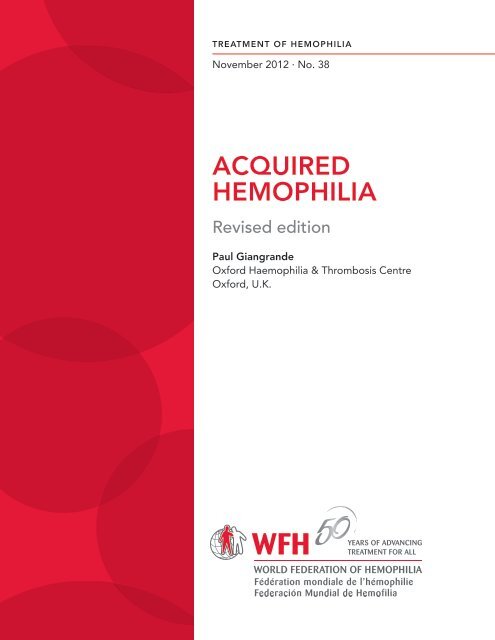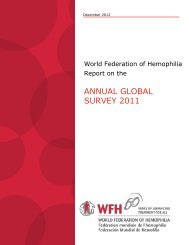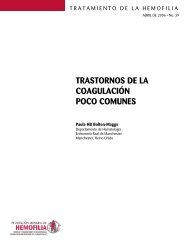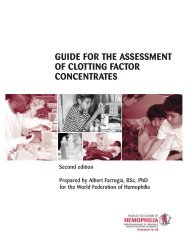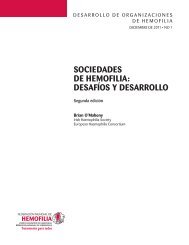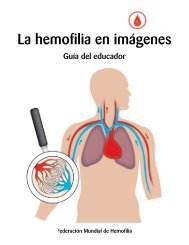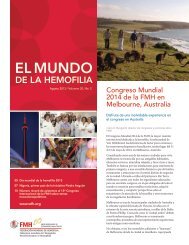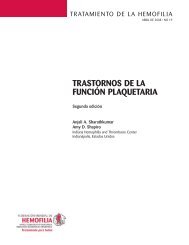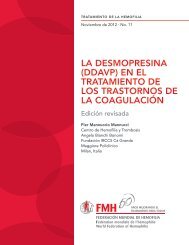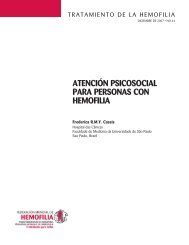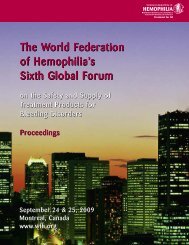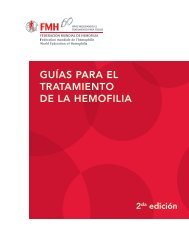ACQUIRED HEMOPHILIA - World Federation of Hemophilia
ACQUIRED HEMOPHILIA - World Federation of Hemophilia
ACQUIRED HEMOPHILIA - World Federation of Hemophilia
- No tags were found...
You also want an ePaper? Increase the reach of your titles
YUMPU automatically turns print PDFs into web optimized ePapers that Google loves.
2Treatment <strong>of</strong> <strong>Hemophilia</strong> No. 38The reason for the completely different bleeding patternin acquired hemophilia remains unknown; there is nodemonstrable impairment <strong>of</strong> platelet function. In a survey<strong>of</strong> 24 cases treated in a single centre over a 28-year period,purpura and s<strong>of</strong>t tissue hemorrhage were the presentingproblems in the overwhelming majority (23) <strong>of</strong> cases[1]. Bleeding into s<strong>of</strong>t tissues can worsen rapidly into acompartment syndrome. Other presentations includedhematuria (4 cases), gastrointestinal bleeding (2 cases),and prolonged postpartum bleeding (4 cases). This studyalso emphasized the potential life-threatening nature<strong>of</strong> the condition as 3 patients (11% <strong>of</strong> the cohort) dieddirectly <strong>of</strong> bleeding complications. Other studies havedemonstrated a similar clinical presentation and mortalityin the range <strong>of</strong> 8-22%, with the highest risk being withinthe first few weeks after presentation [2].It There is <strong>of</strong>ten an underlying medical condition associatedwith this acquired hemophilia. An association withother autoimmune conditions, malignant disease, certaindrugs, and pregnancy has been recognized in varioussurveys. In approximately half <strong>of</strong> all cases, there is noobvious underlying cause and the condition is labelledas idiopathic.EpidemiologyAcquired hemophilia is significantly rarer than the inheritedform, affecting around 2 per million <strong>of</strong> the population[2]. As with the conventional inherited form, it appearsin all ethnic groups and has a worldwide prevalence. Thecondition is <strong>of</strong>ten not recognized or mistaken for otheracquired bleeding disorders such as disseminated intravascularcoagulation (DIC). Case presentations withininstitutions and conferences can help to increase localawareness <strong>of</strong> the disorder among healthcare pr<strong>of</strong>essionalsin other disciplines.Acquired hemophilia typically presents in middle age andbeyond. It rarely arises in childhood, where the presence<strong>of</strong> an inhibitor on laboratory screening <strong>of</strong> a previouslyhealthy child is much more likely caused by the presence<strong>of</strong> a lupus anticoagulant (antiphospholipid antibody).In an analysis <strong>of</strong> pooled data from 20 surveys encompassing249 patients, the median age <strong>of</strong> patients reportedwith acquired hemophilia was 64, with a range <strong>of</strong> 8-93years [3]. In a prospective national study from the UnitedKingdom, the median age at diagnosis was 78 years; only15% were less than 65 years-old at the time <strong>of</strong> diagnosis[2]. An underlying diagnosis such as cancer, autoimmunedisease, or pregnancy was identified in 40% <strong>of</strong> patientsin this series.Laboratory diagnosisThe typical findings <strong>of</strong> acquired hemophilia are aprolonged activated partial thromboplastin time (APTT)and a low factor VIII level. The thrombin and prothrombintimes are normal, as are both the platelet count and function.Mixing studies can be used to demonstrate thepresence <strong>of</strong> a time-dependent inhibitor <strong>of</strong> factor VIII.Details <strong>of</strong> the methodology for the screening <strong>of</strong> plasmasamples for inhibitory antibodies to factor VIII and theirquantification can be found in sections 28 and 34 <strong>of</strong> theWFH laboratory manual, Diagnosis <strong>of</strong> Haemophilia andOther Bleeding Disorders [4]. It is important to distinguishanti-factor VIII inhibitors from the more commonlyencountered antiphospholipid antibodies (or “lupus anticoagulant”).In such cases, no correction <strong>of</strong> the baselineAPTT will be seen immediately after mixing text plasmawith normal plasma.The antibodies in acquired hemophilia are invariablydirected towards factor VIII and not factor IX. The antibodiesare usually polyclonal IgG4 antibodies (rarely IgMor IgA). Most antibodies bind to the 44-kD A2 domainand/or the 72-kD C2 domain <strong>of</strong> factor VIII, and do notfix complement.The kinetics <strong>of</strong> the interaction between factor VIII and theinactivating antibody in acquired hemophilia are unusualand differ from the usual pattern seen in congenital hemophiliacomplicated by inhibitor development. The pr<strong>of</strong>ileshows a non-linear inactivation pattern (type II kinetics),with some residual factor VIII activity identifiable evenafter incubation at high concentrations <strong>of</strong> antibody forsome time. The lack <strong>of</strong> complete inactivation <strong>of</strong> factorVIII even at high concentration is due to the fact thatantibodies in acquired hemophilia may react with factorVIII to form a complex with some residual factor VIIIactivity. What this means in practice is that patients withacquired hemophilia may have measurable factor VIIIbaseline levels even in the presence <strong>of</strong> high titer inhibitoryantibodies. There is therefore a poor correlation between
Acquired hemophilia 3the measureable factor VIII level and bleeding severityin acquired hemophilia, as opposed to what is seen withcongenital hemophilia. A patient with acquired hemophiliaand a factor VIII level <strong>of</strong>, say, 5% can still haveserious hemorrhagic episodes.Clinical managementAcquired hemophilia is a rare disorder and the potentialfor significant bleeding problems is high. It is thereforerecommended that such patients be managed in specialisthemophilia units, which have the necessary expertise andblood products available.It needs to be remembered that many <strong>of</strong> the patientswith this condition are elderly and frail, and may thusbe particularly vulnerable to the adverse effects <strong>of</strong> treatmentwith steroids such as diabetes mellitus, psychosis,osteoporosis, and cataract development. There may wellalso be ethical issues involved in decisions regarding howfar to pursue investigations for underlying pathologyand getting truly informed consent, as well as the cost <strong>of</strong>treatment. At the very least, a thorough medical history,physical examination with a limited panel <strong>of</strong> blood tests,and radiological studies should be conducted to identifyany underlying condition.Recent medication use should be carefully reviewedas the development <strong>of</strong> acquired hemophilia has beenreported as a very occasional adverse reaction to certaindrugs. Drugs that have been implicated in published casereports include antibiotics (such as penicillin, sulphonamidesand cipr<strong>of</strong>loxacin), immune-modifying drugs(interferon, fludarabine), psychotropic drugs (phenytoin,flupentixol, zuclopenthixol), and the antiplatelet agent,clopidogrel. However, this is by no means an exhaustivelist and the possibility that any recent drug couldhave provoked the bleeding disorder must be considered.Many elderly patients may be prescribed medicationsthat can exacerbate the bleeding tendency in acquiredhemophilia through inhibition <strong>of</strong> platelet function, fore.g. anti-inflammatory drugs for osteoarthritis or aspirinor clopidogrel for cardiac disease.Treatment <strong>of</strong> acquired hemophilia is two-pronged [5].The immediate priority is to control acute bleeding withbypassing agents. Immunosuppression should then beused to control antibody production. Human factor VIIIis likely to be very rapidly inactivated by a significant titer<strong>of</strong> inhibitory antibody and therefore <strong>of</strong> no practical use,even at high doses.Treatment <strong>of</strong> acute bleedingThe principal products available for the treatment <strong>of</strong>bleeding episodes are activated prothrombin complexconcentrates (such as FEIBA, which contains activatedfactors VII, IX, and X) or recombinant activated factor VII(NovoSeven). The efficacy <strong>of</strong> both agents is very similarand the choice <strong>of</strong> product and dose is determined by thesite and severity <strong>of</strong> the bleeding. It should be noted thateven extensive cutaneous purpura do not necessarilyrequire treatment.FEIBA is a plasma-derived concentrate which is subjectedto dry heat vapour treatment and nan<strong>of</strong>iltration. Dosesin the range <strong>of</strong> 50-100 units every 8-12 hours are givenby intravenous infusion, but it is important not to exceeda total <strong>of</strong> 200 units/kg within a 24-hour period as thismay be associated with a risk <strong>of</strong> venous thromboembolism.Tranexamic acid should not be given together withthis agent.A recent retrospective survey <strong>of</strong> 34 patients with acquiredhemophilia documented an overall complete responserate <strong>of</strong> 86%, with a typical dosage regime <strong>of</strong> 75 units/kggiven every 8-12 hours [6]. The median number <strong>of</strong> dosesrequired to control a severe bleed was 10, compared to amedian <strong>of</strong> 6 doses for an episode classified as “moderate”.There is no easy way to monitor the response to FEIBA inthe laboratory and clinical judgement must be relied on.Recombinant activated factor VII is an alternative agent,which has the advantage <strong>of</strong> freedom from the risk <strong>of</strong> transmission<strong>of</strong> blood-borne viruses and other pathogens. Areview <strong>of</strong> its use in acquired hemophilia reported an efficacyrate <strong>of</strong> 95% in 139 patients when used as first linetherapy [7]. A typical dose regime would be 90-120 µg/kgadministered every 3 hours until bleeding is controlled.Tranexamic acid may be safely used in combination withrecombinant activated factor VII to inhibit fibrinolysisand thus enhance hemostasis. As with FEIBA, laboratorymonitoring is not easy and response to treatment is bestassessed on purely clinical grounds. Shortening <strong>of</strong> theprothrombin time (PT) will be observed after administration<strong>of</strong> recombinant activated factor VII.
4Treatment <strong>of</strong> <strong>Hemophilia</strong> No. 38There are published case reports <strong>of</strong> venous and arterialthrombosis associated with both bypassing agents,although the risk is arguably lower with recombinantactivated factor VII [8,9]. It is difficult to quantify therisk in the light <strong>of</strong> such isolated case reports but cautionseems warranted in the treatment <strong>of</strong> patients with documentedcardiovascular risk factors. As mentioned above,tranexamic acid should not be given in conjunction withFEIBA.Clinical trials are currently underway to determinethe efficacy <strong>of</strong> recombinant porcine factor VIII in bothcongenital and acquired hemophilia. Its use is based onthe rationale that the structure <strong>of</strong> porcine factor VIII issufficiently similar to the human form to have some hemostaticeffect, but sufficiently different to be less susceptibleto inactivation by circulating antibodies.Suppression <strong>of</strong> inhibitor formationWhile hemostatic agents are administered to controlactual bleeding episodes, some form <strong>of</strong> immunosuppressivetreatment also needs to be given in order to suppressproduction <strong>of</strong> the underlying inhibitory antibody. It isrecommended that immunosuppressive therapy be initiatedas soon as the diagnosis <strong>of</strong> acquired hemophilia isestablished [2,5].The usual treatment involves administration <strong>of</strong> prednisolone(prednisone) at a dose <strong>of</strong> 1 mg/kg combined withcyclophosphamide 50-100 mg/day orally. Azathioprineis an alternative immunosuppressive agent. Treatmentshould be continued for up to two months, with regularreview.Most patients will respond well to such a combination<strong>of</strong> treatment. However, relapse is not uncommon oncethe drugs are stopped or the dose reduced. Patientsshould be followed up for at least one year after treatment.Monitoring <strong>of</strong> the APTT alone is usually quitesufficient if more sophisticated laboratory facilities arenot available [5]. A relapse rate <strong>of</strong> 20% was observed inthe U.K. cohort after a median time <strong>of</strong> 7.5 months (range:1 week–14 months) [2]. This is potentially problematicas it is not feasible to continue this treatment in thelong-term. One option is to use periodic pulses <strong>of</strong> steroidtherapy to maintain a satisfactory factor VIII level, butthe use <strong>of</strong> other immunosuppressive agents should alsobe considered.It has become clear in recent years that rituximab may bea valuable agent in managing acquired hemophilia [10].This anti-CD20 monoclonal antibody is primarily used inthe management <strong>of</strong> lymphoma because <strong>of</strong> its affinity forB lymphocytes. However, it has been successfully appliedin the management <strong>of</strong> various autoimmune conditions,including autoimmune thrombocytopenia.The usual treatment regime involves four separate intravenousinfusions <strong>of</strong> 375 mg/m2 each, administered atweekly intervals. It is generally well tolerated and a clinicalresponse is typically seen within a week <strong>of</strong> the first infusion,with a rise in factor VIII level and a correspondingfall in inhibitor titer. However, rituximab is not licensed byany <strong>of</strong> the major regulatory authorities for the treatment<strong>of</strong> acquired hemophilia and its <strong>of</strong>f-label use to treat thiscondition is likely to need prior approval in many institutions.There is now general consensus that the use <strong>of</strong>rituximab should be considered in cases where patientsprove resistant to first line therapy or in patients in whomsteroids and/or cytotoxics are best avoided. Some groupsnow take the view that the use <strong>of</strong> rituximab should alsobe considered as initial therapy in cases where the initialantibody titer is high.A course <strong>of</strong> rituximab is likely to prove much cheaperthan extended treatment with bypassing agents. A significantrebound with high factor VIII levels has been seenin some patients who have received immunosuppression.For this reason, international guidelines recommend thatconsideration be given to thromboprophylactic measuresin vulnerable immobile patients [5].Mycophenolate is another immunosuppressive agent thathas been recently reported to be both effective and welltolerated in a small number <strong>of</strong> patients with acquiredhemophilia, in whom other treatments do not work. [11].Its use should be regarded as experimental for the timebeingand considered only in patients who do not respondto conventional treatment.Cyclosporin has also been used in several cases [12], andappears effective particularly when systemic lupus erythematosusis the underlying disorder. Long-term treatmentwill require appropriate monitoring <strong>of</strong> plasma levels inorder to minimize toxicity. Cyclosporin is contraindicatedin renal failure.
Acquired hemophilia 5Modern guidelines no longer recommend infusions <strong>of</strong>immunoglobulin or DDAVP as treatment options [5].A meta-analysis <strong>of</strong> 249 cases showed a complete remissionrate <strong>of</strong> 74% after a median follow-up <strong>of</strong> 12 months[3]. The inhibitor-related mortality rate was 11%. Poorprognostic features identified in the review were: age atdiagnosis (
6Treatment <strong>of</strong> <strong>Hemophilia</strong> No. 38References1. Yee TT, Taher A, Pasi KJ, Lee CA. A survey <strong>of</strong> patientswith acquired haemophilia in a haemophilia centre overa 28-year period. Clinical and Laboratory Haematology2000;22(5):275-278.2. Collins PW, Hirsch S, Baglin T, Dolan G, Hanley J, etal. Acquired haemophilia A in the United Kingdom:a 2-year national surveillance study by the UnitedKingdom Haemophilia Centre Doctors’ Organistaion.Blood 2007;109(5):1870-1877.3. Delgado J, Jimenez-Yuste V, Hernandez- Navarro F,Villar A. Acquired haemophilia: review and metaanalysisfocused on therapy and prognostic factors.British Journal <strong>of</strong> Haematology 2003;12(1): 21-35.4. Kitchen S, McCraw A, and Marión Echenagucia forthe WFH Laboratory Sciences Committee. Diagnosis<strong>of</strong> Haemophilia and Other Bleeding Disorders (secondedition). Montreal, Canada: WFH, 2010. Availablein printed format in English and Spanish. May alsobe downloaded free <strong>of</strong> charge from internet viawww.wfh.org.5. Huth-Kühne A, Baudo F, Collins P, Ingerslev J, KesslerC et al. International recommendations on the diagnosisand treatment <strong>of</strong> patients with acquired haemophilia.Haematologica 2009;94(4):566-575.6. Sallah S. Treatment <strong>of</strong> acquired haemophilia with factoreight inhibitor bypassingactivity. Haemophilia 2004;10(2):169-173.7. Sumner MJ, Geldziler BD, Pedersen M, Seremetis S.Treatment <strong>of</strong> acquired haemophilia with recombinantactivated FVII: a critical appraisal. Haemophilia2007;13:451-461.8. Aledort LM. FVIII inhibitor bypassing activity (FEIBA)-addressing safety issues. Haemophilia 2008;14:39-43.9. Abshire T, Kenet G. Safety update on the use <strong>of</strong>recombinant factor VIIa and the treatment <strong>of</strong> congenitaland acquired deficiency <strong>of</strong> factor VIII or IX withinhibitors. Haemophilia 2008;14(5):898-902.10. Franchini M. Rituximab in the treatment <strong>of</strong> adultacquired haemophilia A: a systematic review. Clinicalreviews in Oncology/Hematology 2007; 63(1): 47-52.11. Lee YS, Ng HJ. Mycophenolate in the remissioninduction <strong>of</strong> a patients with acquired haemophilia A.Haemophilia 2010; 16 (1):179-189.12. Petrovic M, Derom E, Baele G. Cyclosporine treatment<strong>of</strong> acquired hemophilia due to factor VIII antibodies.Haematologica 2000; 85(8):895-896.13. Hauser I, Schneider B, Lechner K. Post-partum factorVII inhibitors. A review <strong>of</strong> the literature with specialreference to the value <strong>of</strong> steroid and immunosuppressivetreatment. Thrombosis and Haemostasis 1995; 73(1):1-5.14. Coller BS, Hultin MB, Hoyer LW, Miller F, Dobbs JV,Dosik MH, Berger ER. Normal pregnancy in a patientwith a prior postpartum factor VIII inhibitor: withobservations on pathogenesis and prognosis. Blood1981; 58(3): 619-624.15. Baudo F, de Cataldo F for the Italian Association<strong>of</strong> Haemophilia Centres (AICE). Acquired factorVIII inhibitors in pregnancy: data from the ItalianHaemophilia Register relevant to clinical practice.British Journal <strong>of</strong> Obstetrics and Gynaecology 2003;110(3):311-314.16. Solymoss S. Postpartum acquired factor VIII inhibitors:results <strong>of</strong> a survey. American Journal <strong>of</strong> Hematology1998; 59(1):1-4.
Acquired hemophilia 7GlossaryActivated partial thromboplastin time (APPT): A testthat measures blood clotting ability.Taken together witha normal prothrombin time, prolonged APPT is themost useful screening test for detecting deficiencies <strong>of</strong>factors VIII, IX, XI, and XII.Activated prothrombin complex concentrate(APCC): Plasma-derived concentrate that containsmany activated clotting factors. These activated clottingfactors can bypass certain stages in the coagulationprocess and are used to treat people with factor VIII orfactor IX inhibitors.Anamnestic response: An immune system mechanismin which the memory <strong>of</strong> a previous encounter with aforeign substance triggers the formation <strong>of</strong> antibodies.The rapid increase in inhibitor titer levels as a result <strong>of</strong>an infusion with clotting factor is one example.Antibody: A protein produced by the immune systemthat attacks foreign substances in the body.Autoantibody: An antibody that attacks a person’s ownhealthy tissue.Bethesda units (BU): A measurement for the level <strong>of</strong>an inhibitor in the blood. The BU level indicates thepotency <strong>of</strong> the inhibitor and can be used to determinethe effectiveness <strong>of</strong> factor infusions.Compartment syndrome: A condition in whichincreased pressure (caused, for example, from bleeding)in an enclosed area <strong>of</strong> the body restricts the circulationand can damage nerves, blood vessels, and tissues.Congenital: Present at birth. It refers to traits orconditions that are inherited or occur during gestationup to the moment <strong>of</strong> birth.Cutaneous: Relating to the skin.Hematuria: Blood in the urine caused by bleeding inthe kidneys or bladder.Hemorrhage: A general term for bleeding, eitherinternally or on the surface, with significant blood loss.It may be brought on by injury to blood vessels or by adeficiency <strong>of</strong> certain necessary blood elements such asfactor proteins or platelets.Hemarthrosis: Bleeding into a joint cavity, such as theshoulder, elbow, hip, knee, or ankle.Idiopathic: Occurring without a known cause.Inhibitor: Antibodies made by the body to fight <strong>of</strong>fthings it sees as foreign which prevent, or inhibit, thefunctioning <strong>of</strong> a substance, such as a blood factorprotein.Porcine factor VIII: Factor VIII concentrate madefrom the blood <strong>of</strong> pigs, mainly used to treat people withfactor VIII inhibitors.Postpartum: After childbirth.Prothrombin time (PT): A test that measures bloodclotting ability. Prolonged PT may be an indicator <strong>of</strong>anticoagulants or deficiencies in factors I (fibrinogen),II (prothrombin), V, VII, and X.Purpura: A condition characterized by bleeding intothe skin.Recombinant: The process <strong>of</strong> manufacturing proteinsusing genetic engineering technology. Recombinantproteins are synthetic copies <strong>of</strong> proteins found inhuman blood plasma.Titer: The standard measure <strong>of</strong> the strength orconcentration <strong>of</strong> a component per volume <strong>of</strong> a solution.Half-life: The time is takes for infused factor to losehalf <strong>of</strong> its potency.


